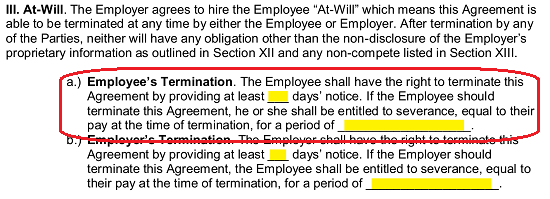Acting for an Employee Work Matters

An ounce of prevention is worth a pound of cure.
— Ben Franklin

Start Here Let's break this into 4 parts.
Seminar
1
History of Work
What is a pun?
US vs UK English
General Employment Vocabulary
Seminar
2
Acting for an Employee
Know Your Rights
Are you joking?
Telecommuting
Seminar
3
Acting for an Employer
How to Document Behavior
At-Will: How to Avoid Getting Sued
US vs UK English
Seminar
4
The Future of Work
Diversity
Work Jokes
Labor Contracts
Let’s Get Started!


“When you don’t respond to bad behavior, you get more of it.”
— Carly Fiorina

How to Document Bad Behavior Take a look at the big picture.
These are the main ways to document and save communication. This may seem easy, but you need to be very careful and take into consideration the following. Documents may be confidential, companies may lock you out of your email account, or there may be a statute of limitations on the timestamp.
Emails
Emails are by far the most common way of documentation in the workplace, so therefore they take the most consideration in being saved correctly.
Hand-written Notes
Hand written notes, logs and journals can all be admitted in court so they are very important to document. Be sure to think about the timing and tone of the handwritten messages and documents.
Text Messages
Whether on your personal phone or a company phone, text messages are being admitted as evidence more and more every day depending on the state you are being consulted in.
When to Start Documenting Getting started right.
If all four of the following become true; it is time to begin documenting.
Do not document every small event as that can be seen as conflictive (by the courts) and possibly trying to set up your employer, we’re on the other hand trying to implicate an employee.
ONE
Leads to Significant Issues at Work
If the activity, for example harassment, discrimination or other activity causes impossible goals, unrealistic schedules, or other obstacles that appear unnecessary.
TWO
Impacts your Work Performance
If any of the above activities cause problems with your work performance.
THREE
Is Suspected to be Illegal
If you think the above mentioned activities are legal.
FOUR
Was Already Reported to HR
If you have an already approached HR without a positive result
START DOCUMENTING
If the above mentioned are all true, this is the opportunity to start documenting activity.
Incorrect Behavior Issues
To document conduct incidents properly, (1) be specific in describing dates, times and places. If an employee is chronically tardy, for instance, you should say, “On these dates, Mr. Jones was late ‘x’ number of times for ‘x’ number of minutes.” (2) Outline the exact rule that your employee broke, and how you expect him to change his behavior. (3) Sign and date the form, and place a copy in the worker’s personnel file.
WHO
The aggressor(s)
The victim(s)
The witness(es)
WHEN
Exact time of day
Day/date
Every repeated event
WHERE
Exact location
General areas
Body areas touched
WHAT
The aggressor’s actions
The victim’s reaction
Neutral play-by-play of the event
WHY
This is not relevant. Please do not make any assumptions that can be misunderstood in court.
HOW TO SAVE DOCUMENTS*
1# – Print out the documents so you can scan them into a personal hard drive later.
#2 – Set up an independent email account, ie. Gmail, yahoo, or Hotmail, but not using your personal account.
#3 – Take photos of the documents.
#4 – Log of important documents.
*Save the entire document, not just the “interesting” pages.
*Companies have sophisticated software, experts to dive into emails.
WHAT TO DOCUMENT
There are many things to consider documenting, however the first is routine work task/behavior issues, second is employee theft, third sexual harassment, and finally substance-abuse on the workplace.
Employee Theft
Instituting proper internal controls can help you determine whether an employee has stolen company property, goods and money. Quarterly financial reviews, for example, may turn up questionable spending patterns that can’t be explained away. Also, ask your bank’s branch manager to notify the company of any suspicious teller transactions. As the investigation unfolds, you should suspend the employee under scrutiny, place him on administrative leave, or transfer him to a different department until you establish what has actually happened.
Sexual Harassment
For employers, sexual harassment allegations are very serious. They can lead to legal liability, including damages, if the employer does not deal with the complaints properly, reports Forbes. The company should notify the Board and inform legal counsel immediately, for guidance on the proper steps.
Thus, careful attention to procedure is essential in sexual-harassment cases. Remind all witnesses about the need for keeping any statements they give you confidential. To further safeguard against leaks, keep a separate file for all investigative documents. If you find evidence of harassment, don’t reference any actions that you take in the employee’s personnel file. Just say that the company imposed discipline for violating its harassment policy, which you can detail in the investigative file.
Substance Abuse
Extended observation is required to establish substance-abuse issues, which can overlap with performance issues. Note every time that an employee doesn’t meet goals, shows up late, or misses a workday. However, don’t include your personal observations. Otherwise, you may risk a lawsuit for making false or misleading statements about the worker. Instead, use the notes as a discussion point. If an employee agrees to get help, note that action, too, and document his progress.
Bear in mind that The Americans with Disabilities Act (ADA) prohibits employers with 15 or more employees from discriminating against employees with disabilities. Addiction to alcohol is generally considered a disability because it impairs a person’s brain and neurological functions. A person who is in recover from drug abuse may also fall within the protections of the ADA.
Here, the situation is complicated. An employer can warn against poor behavior, such as turning up late, and can require the employee to meet the same standards of performance as other employee. However, an employee who is addicted to alcohol must be permitted leave to enter a rehabilitation program, unless this would cause undue hardship to the employer.
Final Considerations
Once your investigation is complete, schedule a meeting to discuss the next steps. Review the situation as you understand it, spell out the consequences and allow the employee to respond, the website Deputy suggests. Have the employee sign any documents that you present, such as written warnings. If the worker refuses, ask another manager to endorse the document, to show that both sides read it. Keep a copy for your reference, but place the original version in the employee’s personnel file.

Your employer can fire you at any time for any reason.
— Common misconception

At-Will Employment Myth v. Reality
Many people in America have heard the term “at-will” employment and many people misunderstand this term. It is an idea that the employer for any reason at any time can fire you. (However it is not the default in the US, there are many exceptions.)
As an employee, you have the right to quit at any time, for any reason.
v.
As an employer, you have the right to fire at any time, for any reason.
Myth
Your employer has to treat you fairly.
Your employer has to treat you kindly.
Your employer has to treat you like the other employees.
Reality
They can fire you at any time, but they CANNOT fire you for ANY reason.
ILLEGAL REASONS
- Discrimination
- Retaliation
- Hostile work environment
- Leave of absence
- Wrongful termination
- Whistleblower status



Section 3 – AT WILL – You should be aware that your employment with the Company is for no specified period and constitutes at will employment.As a result, you are free to resign at any time, for any reason or for no reason.Similarly, the Company is free to conclude its employment relationship with you at any time, with or without cause.
(a)At Will Employment. While we look forward to a long and profitable relationship, should you decide to accept our offer, you will be an at-will employee of the Company, which means the employment relationship can be terminated by either of us for any reason, at any time, with or without prior notice and with or without cause. Any statements or representations to the contrary (and, indeed, any statements contradicting any provision in this Agreement) should be regarded by you as ineffective.

Key Takeaways
- Many common myths.
- Employees can quit at any time.
- Employers can fire at any time, but not for ANY reason.

UK vs. US Which is better?
There are many differences between the UK and the US English first is the pronunciation, second is the spelling and the third is the vocabulary. Today we will explore vocabulary and in the following seminars, spelling and pronunciation.

UK
US

a flat
an apartment
a company
a corporation
1 : a body formed and authorized by law to act as a single person although constituted by one or more persons and legally endowed with various rights and duties including the capacity of succession
a lorry
a truck
1 : an automotive truck used especially for transporting freight
to sack
to fire
1 : INFORMAL : to remove from position or service. FORMAL : to dismiss
to make redundant
to lay off
1 : discharge a worker temporarily or permanently because of a shortage of work
to go on holiday
to go on vacation
1 : to take time away from work or school for leisure and travel
the post
the mail
1 : public system designed to deliver letters and packages

Key Takeaways
- Both terms are correct.
- Consistency is the most important part.
- Every Brit secretly wishes to be American. 😉
About the Author Eric Froiland
Eric is a legal English teacher from the United States and has been based out of Bogota, Colombia for the last 10 years. He is the owner and founder of Legal English Innovation SAS, which is recognized as the top legal English academy in Colombia and is an official Test of Legal English Skills (TOLES) examination center.





